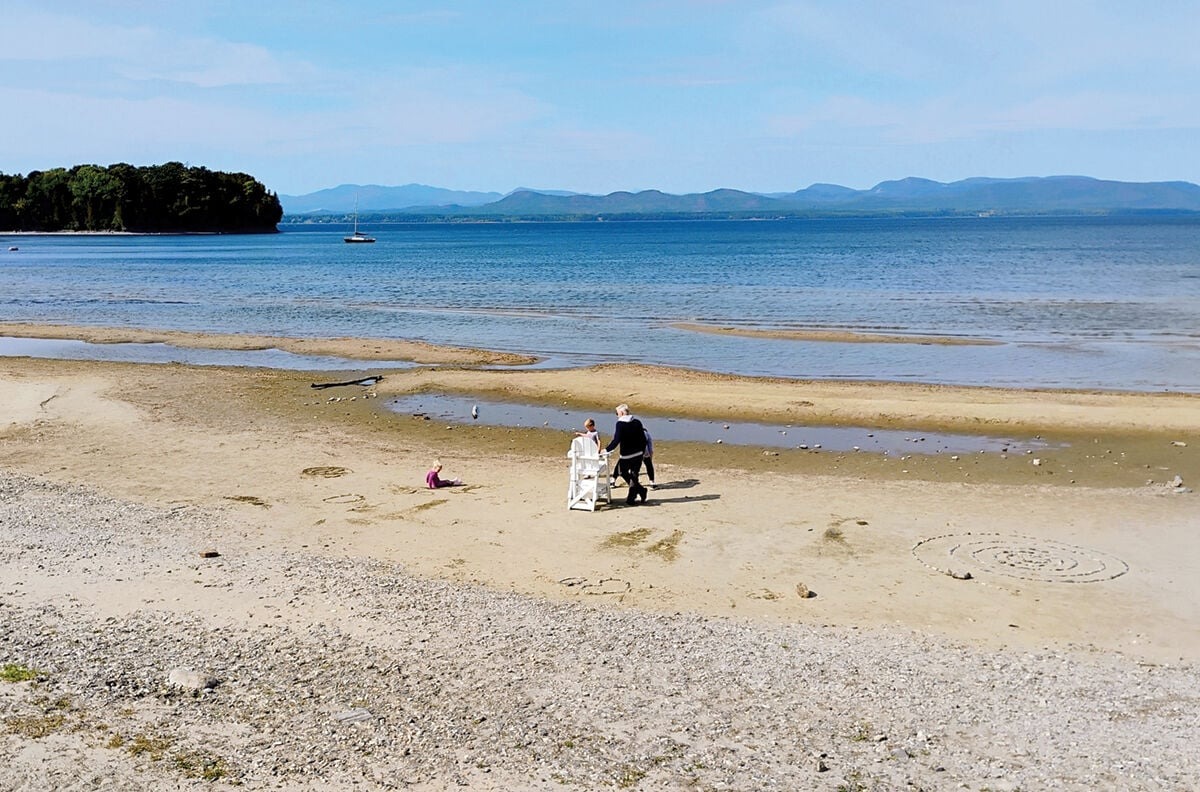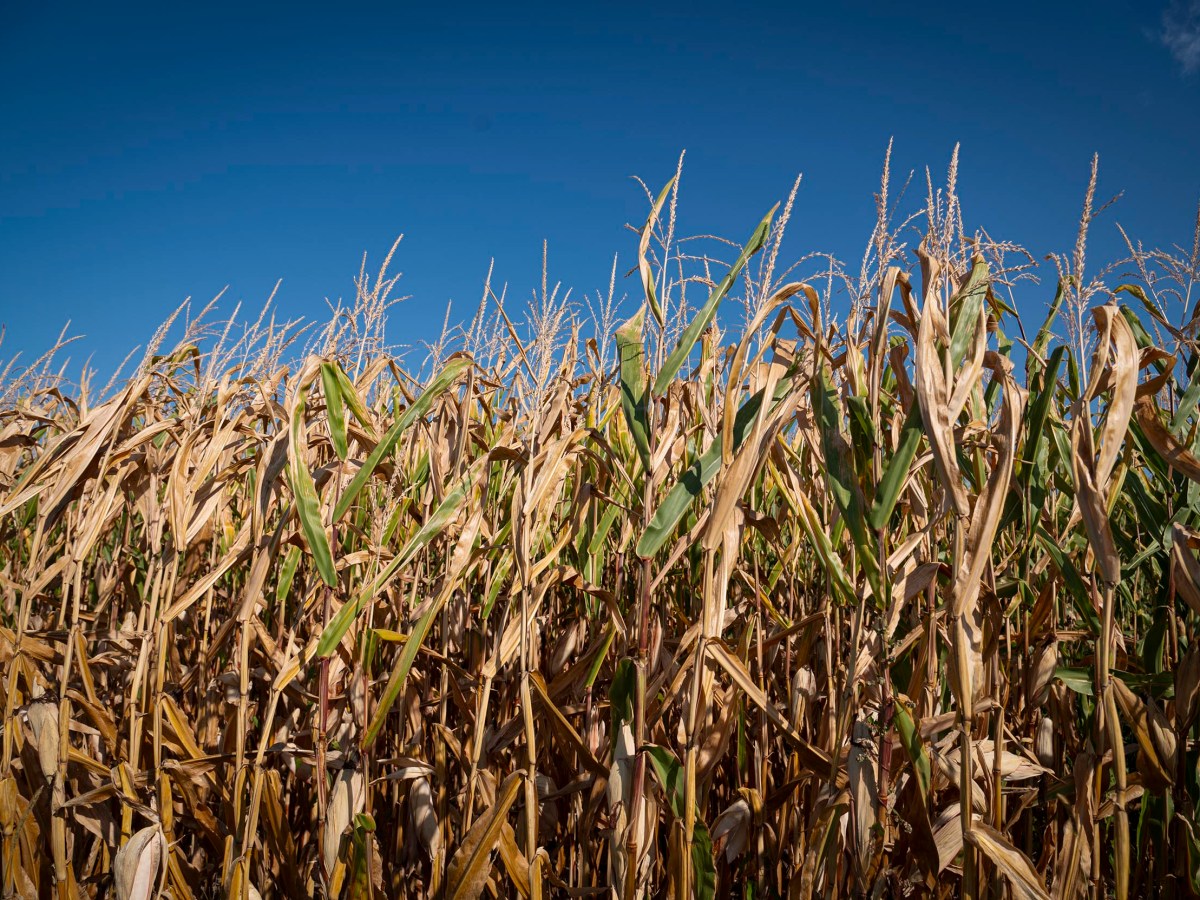 Shelburne Beach, like many beaches on Lake Champlain, is experiencing near-historic low water levels, stretching the beach out further. Photo by Jim Koehneke/Shelburne News
Shelburne Beach, like many beaches on Lake Champlain, is experiencing near-historic low water levels, stretching the beach out further. Photo by Jim Koehneke/Shelburne News
This story by Briana Brady was first published in the Shelburne News on Oct. 2, 2025.
Anyone taking a walk near Shelburne Beach can see it: the lake is low. The beach stretches out farther than some may have ever seen it. Lake Champlain is nearing a historic low water level that was recorded in 1908.
Despite some rain in the last week or so, most of Vermont is considered in “severe” or “extreme” drought, with the worst off areas in the southern half of the state. While the water levels in the lake might be one of the most visible impacts of the drought, ecosystems from the headwaters of the LaPlatte River to the wetlands it travels through are feeling the impacts.
“So much of the effects of climate change are like an extreme storm or it’s not raining outside, but the lake is like a signal. It’s a signal we can see and we can touch and we can jump into or walk on top of, based on what the weather is doing, what the climate is doing,” Matthew Vaughn, the lead scientist at the Champlain Basin program said.
READ MORE
by Alice Finno
October 3, 2025, 6:59 pmOctober 6, 2025, 10:18 am
According to scientists, this drought is part of a cycle of floods and drought Vermont has been experiencing, exacerbated by climate change, and the long-term effects are largely unknown.
A perennial concern for the watershed and the lake is the amount of phosphorus in the system, which can cause dangerous algae blooms. According to Vaughn, the impact of drought on the level of phosphorus in Lake Champlain is not even — it depends on the weather and the location.
With little wind and low water levels in shallow parts of the lake, phosphorus that has sunk in sediment to the lakebed may be released into less water. That can create higher concentrations of phosphorus. According to Vaughn, he is less concerned about Shelburne Bay experiencing more concentrated phosphorus during this drought than other areas — Shelburne is much closer to meeting its water quality target, and recently there has been at least some rain.
In fact, in some places, Vaughn noted, the lake might show lower levels of phosphorus than usual. Less water moving through the system means less phosphorus reaching the lake. However, the phosphorus will still build up in the system — when it does rain, everything will still wash downstream.
Like the lake, the surrounding wetlands are also much drier. Although shorebirds might be experiencing expanding feeding grounds in shallow, muddy areas, for animals like waterfowl, their nesting areas may not be as available. The trend continues upstream.
“We’re finding our cold-water species are the ones we’re most worried about, but we find that they’re holding on as long as there’s pools with cold water in them,” said Will Eldridge, an aquatic habitat biologist with Vermont Fish and Wildlife.
The brook trout, for example, Eldridge noted, seem to be doing alright. They haven’t experienced any large decline in population. Although there are some areas without water, and therefore no fish, those that have found pools of water to wait out the drought are surviving. Partially, he said, this might be thanks to the fact that during this drought period, Vermont didn’t simultaneously experience extreme heat — the streams and pools stayed cool, as most of the water flowing through them is ground water.
However, the recharge of groundwater is its own issue.
This summer, after finding a large leak in its water system, which currently operates on a single well, Hinesburg halted all new water allocations. Concerns about water in town were exacerbated by the drought.
“Especially in a time like this, when we haven’t had any significant rain to help replenish the aquifer in a while, and that, you know, looking forward, it doesn’t seem like there’s going to be any for a while,” town manager Todd Odit said at a selectboard meeting at the end of August.
Groundwater in Vermont is often replenished not just from rains throughout the spring and summer, but also through snowpack. In fact, according to Eldridge, during winter, snow often leads to a greater recharge of the system than rain, slowly absorbing into the ground rather than running off into streams and rivers.
The drought, the floods of the last couple of years, all of it is related to climate change. Summer droughts like the one Vermont is experiencing may show us how low aquifers can get, but warm, rainy winters might be setting the stage for those droughts.
“There’s things that we’ve shown have recharged the groundwater and actually helped maintain base flow during dry periods,” Eldridge said. The example he gave were establishing headwater wetlands — areas that will better absorb water even without snowpack during the winter. In places like the LaPlatte headwaters, this might help the aquatic ecosystem maintain during drought.
Both Eldridge and Vaughn agree that the current drought is part of what seems to be a recurring cycle: drought and flooding.
“My greater concern definitely is, are the extremes we’re seeing where we have, you know, two years of really extreme, unusual flooding, where we had, like, episodic events that brought a lot of rain all at once for over a day or two period, and now this pretty notable dry spell just within a few years, I think we’re really seeing the effects of climate change, and we’re seeing it too with our patterns of precipitation, even in typical years,” Vaughn said.
Latest stories
by Auditi Guha
October 7, 2025, 7:30 pmOctober 7, 2025, 8:11 pm
by Valley News
October 7, 2025, 6:28 pmOctober 7, 2025, 6:32 pm



